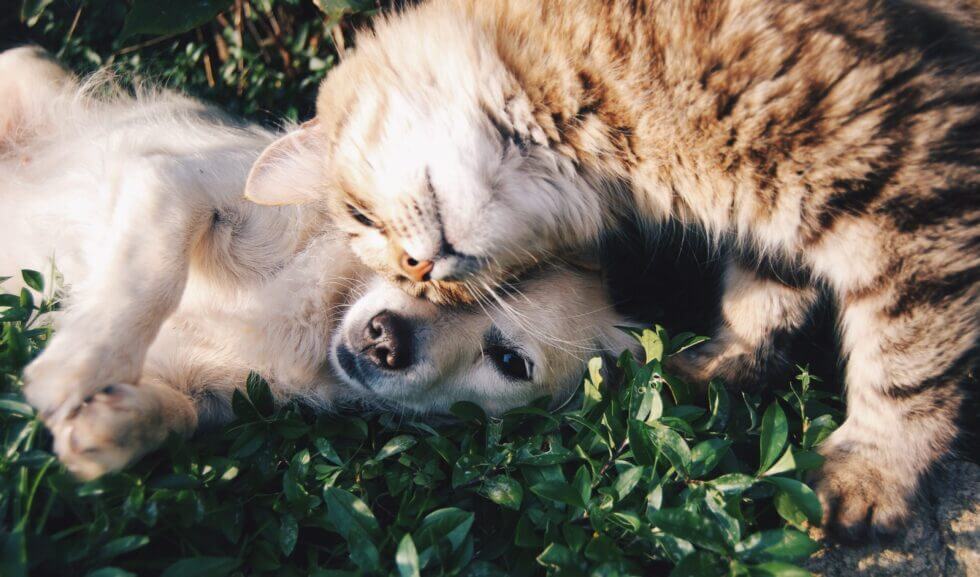
As a pet owner, you want what is best for your pet. Vaccinations are one of the many important factors of your pet’s overall health. Yearly vaccines can help prevent serious, and sometimes deadly, diseases. There are many vaccines that are offered at the veterinary clinic. You may be asking, what vaccines does my pet need and why do they need them?
Rabies (Dog & Cat)
Rabies is a viral disease that attacks the nervous system of mammals. The virus travels from the nervous system into the brain causing fearfulness, aggression, excessive drooling, difficulty swallowing, paralysis, seizures and eventually death. It is secreted and transmitted through saliva. The virus is spread when one infected animal bites another animal. Once symptoms are shown, rabies is 100% fatal with no treatment, so prevention is key. This deadly viral disease is preventable with the Rabies vaccine. The vaccine is started at 16 weeks of age and then it is boostered yearly. A three year vaccine is also available to dogs over one year of age who have previously had the 1 year vaccine at 16 weeks of age.
Canine Distemper
The Distemper vaccine includes Distemper, Adenovirus, Parainfluenza, and Parvovirus. These are a group of contagious diseases that affect the gastrointestinal system, respiratory system, and the nervous system. This vaccine is started at 8 weeks old, then it is boostered every 3-4 weeks until they are 16 weeks of age. It is boostered 1 year later and every 3 years after that.
Distemper
Dogs become infected with the Distemper virus through airborne exposure or shared food and water bowls from an infected dog or wild animal. Once dogs are infected they can shed the virus for months, and mothers can pass the virus to their puppies. Symptoms include discharge from the eyes and nose, fever, coughing, lethargy, reduced appetite, and vomiting. As the virus progresses it attacks the nervous system. Dogs will then begin to develop signs that include head tilt, muscle twitches, convulsions with jaw chattering, seizures, and paralysis. Prevention is very important because Distemper is often fatal. Dogs that survive usually have permanent damage to their nervous system.
Adenovirus
Adenovirus causes infectious hepatitis in dogs, which is inflammation of the liver. The virus is transmitted by direct contact of infected urine, nasal and eye discharge. Symptoms include decreased appetite, fever, eye/nasal discharge and coughing. In more severe cases, dogs may develop abdominal pain, vomiting, diarrhea, edema of the head/neck, and possibly jaundice. These more severe cases may be fatal. Other than symptomatic treatment, there is no specific cure for Adenovirus and prevention is key.
Parainfluenza
Parainfluenza is a highly contagious respiratory virus that causes coughing, fever, nasal discharge, decreased appetite, and lethargy. It is transmitted through airborne exposure from sneezing, coughing, or barking. Parainfluenza can also be spread indirectly through clothing, collars, leashes, and shared food/water bowls. Dogs that go to boarding, grooming, day care, or kennels are at a higher risk of infection. Treatment for Parainfluenza is supportive care.
Parvovirus
Parvovirus is a highly contagious virus that affects the gastrointestinal tract of dogs. It is spread by direct dog to dog contact. Signs include lethargy, loss of appetite, abdominal pain, fever or hypothermia, vomiting, and severe bloody diarrhea. Parvovirus may lead to death within 48-72 hours after symptoms are shown and intense supportive care is needed for treatment.
Bordetella (Canine)
Bordetella is otherwise known as Kennel Cough. This is a highly contagious respiratory infection that causes our pets to have a cough that is often compared to a goose honk. It is contracted where large amounts of dogs gather, like boarding, grooming, doggy day care, or dog parks. The vaccine is offered in an oral or injectable version. It is started at 8 weeks old and is then boostered yearly.
Lyme (Canine)
Lyme disease is spread through tick bites, more specifically an infected Black Legged Deer Tick (Ixodes scapularis). This disease causes lameness, fever, and joint swelling. If your pet is exposed to ticks, like in forests, tall grassy areas etc, the vaccine is highly recommended. It is started at 12 weeks of age, then it is boostered in 3-4 weeks. After that it is a yearly vaccine.
Leptospirosis (Canine)
Leptospirosis is a bacteria spread in the urine of infected animals. It can lead to kidney & liver failure. Risk factors include exposure to any bodies of water including lakes, rivers, streams, even puddles. Even if you live in a big city, if it rains then your pet is exposed. Leptospirosis is zoonotic, meaning it can be transmitted to humans. The vaccine is started at 12 weeks of age, then it is boostered in 3-4 weeks. After that it is a yearly vaccine.
Feline Distemper (FVRCP)
The Feline Distemper vaccine includes a group of highly contagious viral diseases. These diseases are Feline Viral Rhinotracheitis, Calicivirus, and Panleukopenia. They are all spread through direct contact with other infected cats. There is no cure for any of them and treatment is intensive and symptomatic. Vaccination is the best way to prevent this group of viral diseases. Once a cat is infected with any of these viruses, they become a lifelong carrier and isolation is imperative to prevent spread of the disease. The vaccine is started at 8 weeks old, then it is boostered every 3-4 weeks until they are 16 weeks of age. It is boostered 1 year later and every 3 years after that.
Feline Viral Rhinotracheitis
Feline Viral Rhinotracheitis is a viral disease caused by the feline herpesvirus. A cat becomes infected through direct contact with saliva, eye discharge, or nose discharge of other infected cats. Symptoms of FVR include sneezing, nasal congestion, conjunctivitis, discharge from the eyes and nose, fever, lethargy, decreased appetite, and enlarged lymph nodes. Cats may not show signs of infection because the virus lays dormant. If they become stressed then the symptoms will flare up again. There is no cure for the infection and treatment is symptomatic.
Calicivirus
Feline calicivirus is spread the same way Feline Viral Rhinotracheitis is and it has similar symptoms. Calicivirus also causes painful ulcers in the mouth, so infected cats will often salivate or drool excessively. There is no treatment for it and supportive care is needed.
Panleukopenia
Panleukopenia is a viral disease caused by feline parvovirus. The virus is shed in infected animals urine, stool, and nasal discharge. The feline parvovirus infects and kills cells in the bone marrow, intestines, and the developing fetus. This causes a low white blood count, which makes them more prone to infections. The virus in the intestines leads to severe diarrhea. There is no treatment for it and supportive care is needed.
Feline Leukemia (FeLV)
Feline Leukemia is a virus that attacks cells of the cat’s immune system and blood forming tissue. It can cause lifelong infection that leads to a weakened immune system and chronic illness. Cats are then more likely to become severely ill from things like bacteria, viruses, protozoa, and fungi. Cats may develop a low red blood cell count, otherwise known as anemia. Other common symptoms associated with FeLV include severe inflammation of the intestines, neurological disease, and ocular disease. It is spread through direct contact with infected cats. Pregnant cats may pass the virus down to their kittens, and mothers can also pass it down by grooming them. There is no cure for FeLV, and treatment is symptomatic and may only be temporary. FeLV is fatal and studies have shown that 80-90% of infected cats will die within 3-4 years of being diagnosed. Once a cat has been diagnosed with FeLV, keeping them away from other cats is imperative to prevent the spread of disease. The vaccine is highly recommended for outdoor cats that are exposed to other cats. It is started at 12 weeks of age, then it is boostered in 3-4 weeks. After that it is a yearly vaccine.


